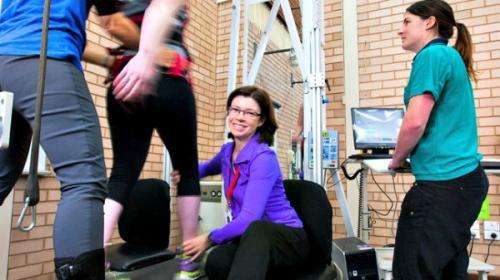UWA's Professor Sarah Dunlop supervises a patient’s treadmill training as part of 'use it or lose it' trials for treating spinal injuries. Credit: UWA/Matthew Galligan
WEST Australian researchers are taking part in an innovative 'use it or lose it' approach to treating spinal injuries, with the potential to revolutionise the way such injuries are treated.
Three randomised control trials are underway as part of a multi-million dollar research project involving the University of WA, eight spinal units in Australia and New Zealand, and more than 300 patients with paraplegia or quadriplegia.
The trials aim to assess the impact of regular training or exercise—as soon as possible after spinal injury—on the regeneration of damaged nerves and outcomes of subsequent treatment.
Professor Sarah Dunlop, Head of UWA's School of Animal Biology and lead of the WA arm of the Spinal Cord Injury and Physical Activity (SCIPA) research project, says the physical training aims to return the body to its best possible condition for subsequent therapy.
"One of the three trials looks at moving the paralysed limbs in bed by strapping a bike to the end of the bed and putting stimulating electrodes on the legs, so [patients] can help drive the circuitry and move [their] legs as soon as it is safely possible after the injury," says Professor Sarah Dunlop.
The second trial involves patients training themselves to use their hands again by using a Bluetooth transmitter on their ear to control a cuff on their arm.
By clicking their teeth, patients can send a signal from the vibration-sensitive transmitter to the cuff, and thus move their hand.
"They can contract and relax their muscles, and open and shut their hands," says Prof Dunlop.
"They then use the hand to play a computer game by essentially moving a rod on a stick ... so they are driving themselves to use their hands."
In the third trial, patients move their whole body, participating in three weekly sessions of cycling, pilates or treadmill work, some six months after their accident.
"We get them upright on a treadmill and harness them in, so they're supported safely and physiotherapists—one for each leg—help them do a natural stepping motion," she says.
The WA component of the studies involves more than 50 patients and about 30 staff.
The research findings are due to be published in 2015.
Provided by Science Network WA






















